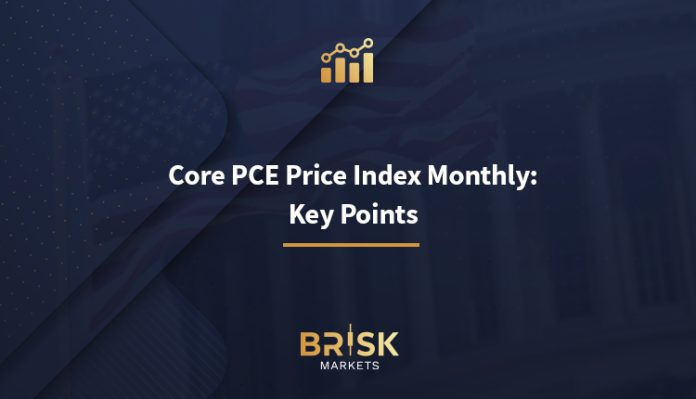The Core Personal Consumption Expenditures (PCE) Price Index (monthly) is a leading economic indicator used to measure the change in the prices of goods and services purchased by consumers, excluding food and energy prices, from one month to one month. the next. Here are the key points about the monthly core personal consumption expenditures price index:
Definition and purpose
• Core PCE Price Index: This index specifically excludes volatile food and energy prices to provide a clearer view of underlying inflation trends.
• Month-to-month: This measures the change in prices from month to month and provides a short-term perspective on inflation.
Importance
• Fed’s preferred measure: The core personal consumption expenditures price index is closely watched by the Fed because it reflects changes in the cost of living and is a key measure of the Fed’s 2% inflation target.
• Monetary Policy Decisions: Changes in core personal consumption expenditures can affect the Federal Reserve’s decisions on interest rates and other monetary policies. A higher-than-expected increase may lead to higher interest rates to curb inflation, while a lower-than-expected number may lead to lower interest rates or more accommodative policies.
Calculation
• Data collection: The index is based on data from the Bureau of Economic Analysis (BEA), which collects information on the prices of various goods and services consumed by households.
• Exclusions: By excluding food and energy, the index aims to smooth out short-term fluctuations caused by price fluctuations in these categories, providing a more stable and reliable measure of inflation.
Release schedule
• Monthly Report: The Core PCE Price Index is released monthly, usually at the end of the month, and covers the previous month’s data.
• Accompanied by other data: Usually released in conjunction with the Gross Personal Consumption Expenditures Price Index, which includes food and energy prices, and other personal income and spending data.
Expected personal consumption expenditure inflation for March 2024
The Personal Consumption Expenditures (PCE) price index for March is expected to show a mixed picture of inflation trends, which could reinforce the Fed’s resolve to delay interest rate hikes.
Analysts expect the overall personal consumption expenditures price index to rise slightly year over year to 2.6% from 2.5% in February, according to FactSet. However, they also expect the monthly change of the index to fall to 0.30% from 0.33%.
When volatile food and energy costs are taken into account, economists expect core personal consumption expenditures inflation to rise by 2.7%, down slightly from the 2.8% year-on-year increase in February. However, the consensus estimate for core PCE inflation is for a monthly increase to 0.30% from 0.26% in February.
The CPI report typically overshadows the Personal Consumption Expenditures report, but the latter is the Fed’s preferred way of tracking inflation. With the CPI showing inflation progress has stalled, the Personal Consumption Expenditures Index is gaining more attention as Fed officials expressed waning confidence about the likelihood of inflation continuing to decline toward their 2% target.
Economist wrote that the core PCE deflator “may have advanced another 0.3% in March. On an across-the-board basis, our estimate is a ‘low’ 0.3% at 0.256%, which if achieved would lead to to an annualized pace of 2.7%, after 2.8% in February and 2.9% in January… In recent appearances both Chairman Powell and Vice Chairman Jefferson have pointed to the Fed’s estimate of March core PCE inflation at 2.8%.
Preliminary Estimates: Income and personal expenses rise in April
Personal income rose by $65.3 billion (0.3 percent monthly) in April, according to estimates released today by the Bureau of Economic Analysis. Disposable personal income (DPI) — personal income minus current personal taxes — increased by $40.2 billion (0.2 percent) and increased Personal consumption expenditures (PCE) of $39.1 billion (0.2 percent).
The personal consumption expenditures price index rose 0.3 percent. Excluding food and energy, the PCE price index rose 0.2 percent and real DPI prices fell 0.1 percent in April and real DPI fell 0.1 percent. Goods fell 0.4 percent and services rose 0.1 percent
The increase in personal income in current dollars in April primarily reflects increases in compensation, personal income receipts on assets, and government social benefits to people.
The $39.1 billion increase in personal consumption expenditures in current dollars in April reflects a $49.1 billion increase in spending on services that was partially offset by a $10 billion decrease in spending on goods. In the services sector, the largest contributors to this increase were housing and utilities (led by housing), health care (outpatient and hospital services), and financial services and insurance (led by financial services fees, fees and commissions). These increases were partially offset by a decrease in transport services (led by air transport). Among goods, the largest contributors to the decline were spending on leisure goods, vehicles (led by information processing equipment) and other non-durable goods (led by leisure items). Detailed information about monthly PCE spending can be found here.
Personal expenditures — the sum of personal consumption expenditures, personal interest payments, and personal current transfer payments — increased by $42.8 billion in April. Personal saving reached $744.5 billion in April, and the personal saving rate — personal saving as a percentage of disposable personal income — was 3.6 percent.




